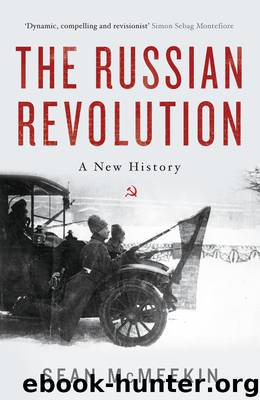The Russian Revolution by McMeekin Sean;

Author:McMeekin, Sean;
Language: eng
Format: epub
Publisher: Profile Books
Dzerzhinsky’s Cheka was also tasked with containing the political fallout from the recent national parliamentary elections (conducted on November 12, it had taken until the end of the month for all the ballots to be counted). Considering the circumstances, the elections of November 1917 were conducted with remarkable integrity, with a turnout of 41 million, half of eligible voters. As expected, the SRs won a plurality, scoring just above 40 percent, with the Bolsheviks coming in second at 24 percent (though Lenin’s party won nearly 50 percent of the army, including 70 percent of serving men in Moscow and Petrograd). Impressive though this was in comparison to where the Bolsheviks had stood just months earlier, it was hardly reassuring to a ruling party of usurpers that more than three quarters of the Russian electorate had voted against them, leaving them with only 175 seats out of 707. As one observer noted, the democratic verdict sat with the Bolsheviks like a “bone in the throat.” And so Sovnarkom, refusing to ratify the results as legitimate, postponed the convocation of Russia’s long-awaited Constituent Assembly, originally scheduled for November 28, until “electoral abuses” could be investigated, and it instructed the Cheka to close off Taurida Palace to prevent opposition forces from gathering there.23
Meanwhile, Lenin’s war with the banks stepped into high gear. On December 14, the Soviet Finance Ministry abolished private banks in Russia while granting broad powers to a new managing director of the “Commissariat of Formerly Private Banks,” Grigory Sokolnikov. There was an element of fantasy here, in that Sokolnikov, a young party activist with no experience in the banking industry, did not even know where many banks were (his first order to subordinates was literally to prepare a list of their addresses and phone numbers). The Bolsheviks having failed, owing to the employee strike, to obtain access to the vaults where state reserves (including gold) were stored, Sokolnikov instead laid claim to private bank deposits, with the exception of savings accounts held by proletarians not belonging to the “rich classes,” with the cut-off at 5,000 rubles or a monthly income of 500. In this way, private property in Russia would be “annihilated.”24
The first reports from the banks Sokolnikov surveyed bristled with talk of “sums of incredible size” on deposit. By confiscating the private savings of rich Russians, the Bolsheviks aimed to acquire 2 to 3 billion rubles—$1 billion to $1.5 billion at the time, the equivalent of $100 billion to $150 billion today. And so it came about that on December 21, 1917, notices appeared all over Petrograd announcing that, “to combat bank speculation and the regime of capitalistic exploitation… the late private banks have been occupied by armed forces.” Next day more notices appeared, explaining that on December 23 “will take place the revision of the safes at the following banks: International, Siberian, Russian Commercial and Industrial, Moscow Merchants’, and Moscow Industrial (late Junker’s).” Explaining what “revision” meant, the notice stipulated that “owners of safes from Nos. 1 to 100 at the said banks are to appear with their keys at 10 a.
Download
This site does not store any files on its server. We only index and link to content provided by other sites. Please contact the content providers to delete copyright contents if any and email us, we'll remove relevant links or contents immediately.
| Africa | Americas |
| Arctic & Antarctica | Asia |
| Australia & Oceania | Europe |
| Middle East | Russia |
| United States | World |
| Ancient Civilizations | Military |
| Historical Study & Educational Resources |
Red Famine: Stalin's War on Ukraine by Anne Applebaum(2817)
Chernobyl by Serhii Plokhy(2440)
Midnight in Chernobyl by Adam Higginbotham(2391)
The House of Government by Slezkine Yuri(2105)
Midnight in Chernobyl: The Untold Story of the World's Greatest Nuclear Disaster by Adam Higginbotham(2079)
Red Shambhala by Andrei Znamenski(2073)
The Gulag Archipelago (Vintage Classics) by Aleksandr Solzhenitsyn(1987)
All the Kremlin's Men by Mikhail Zygar(1962)
From Cold War to Hot Peace by Michael McFaul(1942)
Red Notice by Bill Browder(1933)
Putin's Labyrinth(1903)
The Future Is History by Masha Gessen(1822)
From Russia with Lunch by David Smiedt(1798)
A People's Tragedy by Orlando Figes(1770)
The Romanovs by Simon Sebag Montefiore(1723)
How to Tame a Fox (and Build a Dog): Visionary Scientists and a Siberian Tale of Jump-Started Evolution by Lee Alan Dugatkin & Lyudmila Trut(1681)
Putin's Labyrinth: Spies, Murder, and the Dark Heart of the New Russia(1664)
The Lost Spy by Andrew Meier(1635)
Art and Revolution by John Berger(1608)
